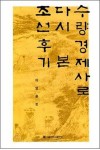
Rhee Young Hoon (ed.)
Seoul National University Press 2004, 409 pages
Reviewed by Ilsoo David Cho (Ph.D. Student, Department of East Asian Languages and Civilizations, Harvard University)
A Cliometric Review of Late Chosŏn History is a collective effort by eight Korean scholars in the quantitative economic history of late Chosŏn Korea. Produced as a part of a larger institutional effort by the Naksungdae Institute of Economic Research to review and analyze economic statistics of Korea from 1650 to 2000, this volume focuses on late Chosŏn (circa 1650-1910) using a number of important but previously unused or underutilized sources. Through careful analysis of diverse and original sources such as financial records of local governments, lineages and private academies, individual diaries, land transaction records, and central government wage records, the authors of this book analyze diverse aspects of late Chosŏn economy including population, wages, interest rates, prices of rice paddies, prices of commodities, rice productivity, rice markets, and forestry. While individual arguments of the eight main chapters of the book are as diverse as the different topics they touch on, they come together in making three sweeping points about economic history of late Chosŏn Korea: 1) non-capitalist economic institutions remained powerful to the end of dynasty; 2) 18th century Korea experienced relative stability; 3) 19th century Korea faced serious economic deterioration to a point that, according to the book’s editor, it practically “self-destructed” even before Japanese colonized the country.
The overall arguments of this book are provocative in the sense that they fundamentally challenge the still-dominant current of Korean historiography in Korea—“internal development” theory. It was formulated largely in response to the so-called colonialist historiography that justified Japanese colonization of Korea. For example, economic historian Fukuda Tokuzo (1874-1930) had argued that Korean society around the time of colonization was stagnant and stuck at the stage of ancient village economy. Clearly aware of the political repercussions of such an understanding of Korea during the colonial period (1910-1945), Korean economic historian Paek Nam’un (1895-1974) had fought back with “capitalist sprouts” theory. Paek argued that capitalism was already emerging in late Chosŏn, but Japanese imperialism later distorted its development. Korean historians led by Kim Yongsŏp (1931- ) continued to develop such meta-narratives into “internal development” theory, arguing for Korea’s autonomy in its historical development. “Internal development” theory has already faced criticisms from a number of scholars who argue for the importance of external stimuli in Korea’s development and post-modern scholars who reject the validity of Marxist meta-narrative itself. Rhee Young Hoon et al.’s findings, however, are particularly devastating to “internal development” theory as they empirically “prove” that late Chosŏn Korea was stagnant and deteriorating. As Rhee notes, this book’s findings throw the field of Korean history, if not the entire Korean society, into disarray.
This book is not without shortcomings. Most sources used in the book are fragmentary and were excavated from the Chosŏn Korea’s southern provinces. Limitations in terms of sources make it difficult know whether the book’s findings reflect national trends or whether significant differences existed in northern Korea. As the authors acknowledge, more research is needed to fully establish the book’s arguments. Nevertheless, A Cliometric Review of Late Chosŏn History is an important work that fundamentally challenges older views and suggests new directions in historical research.
